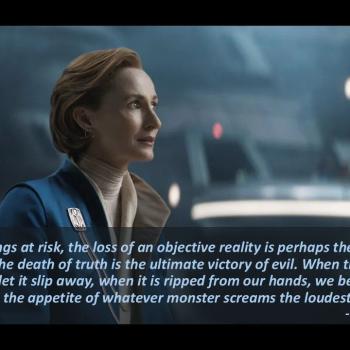I am currently working on a statement of my teaching philosophy, and decided (as with most other things I do) to share it on my blog, in the hope both that I may receive helpful feedback, as well as in the hope that it may be helpful and useful to others. As I worked on writing it, I found that I could not simply repeat all of the statements I had made in the past, even though much has remained the same. By sharing not only my present outlook and approach, but also commenting on where it has remained the same and where it has changed, it is my hope that this teaching statement will be more meaningful.
I have emphasized, ever since I began my teaching career, the importance of critical thinking, as the most important skill I seek to cultivate in students. In light of the use of the phrase “critical thinking” and the concept of “fairness” in attempts to undermine science education and introduce subjects such as intelligent design into science classrooms, I feel it is essential to clarify what such concepts have come to mean to me over the course of my teaching career thus far.
At the outset, I considered my role as a professor of religion to be, ideally, that of an impartial moderator, and when necessary also devil’s advocate. My aim was, first and foremost to stimulate student discussion of key primary and secondary literature that they were assigned to read. My own views on religious matters I felt ought to be kept outside the classroom, lest I cross the border between teaching about religion and be accused of bias or even indoctrination. With the benefit of hindsight, I can see that this is unrealistic. Even my starting position, that critical thinking and scholarly study are appropriate undertakings for all my students, including those with personal faith commitments, is itself a value-laden viewpoint, and in teaching from this perspective, I was not, as I had supposed, engaging in a value-free, purely intellectual activity. In the field of Biblical studies, as in all other areas of academic inquiry, there are things that we know with as great a degree of certainty as is possible, and others where even experts differ on the implications and interpretations of the relevant evidence. I thus now emphasize not only the need for critical thinking broadly defined, but also the essential skill of identifying credible sources. This is particular important in an age when web sites representing every conceivable opinion abound, and it is to the internet that students first turn as a source of information. By learning to distinguish between mainstream and fringe viewpoints, and understand why a majority of scholars in a given field reach a particular conclusion, is also an essential component of critical thinking. Without a clear understanding of the evidentiary basis of different scholarly views, and of why legitimate disagreement arises where it does, students’ critical thinking skills will be at best incomplete, and at worst prone to argue for a conclusion based on personal preference without due concern for either evidence or potential consequences. To provide an example, no serious historian doubts Jesus’ existence, just as no credible historian thinks Jesus spoke exactly as he is presented as speaking in the Gospel of John. On such matters, the evidence is relatively clear cut, and the fact that students can find someone with a PhD who holds an alternative viewpoint and repeat their arguments does not, in and of itself, represent critical thinking. The missing component is an understanding of why there is near unanimity about particular conclusions, since these are especially striking in a field such as history, which deals only in probabilities. Also missing is an awareness that fringe viewpoints are regularly driven by and based on ideological motivations rather than evidence. Thus it is that my emphasis on instilling in students the ability to think critically about important issues, and draw their own conclusions, has not changed, but has nonetheless been tempered significantly by an increased emphasis on understanding the reasons for scholarly consensuses and disagreements – the former suggest that the evidence we now have points strongly to a particular conclusion (although new evidence can always unseat old certainties), while the latter suggests that there is a degree of ambiguity in the evidence currently available that leaves room for more than one interpretation thereof. Having made these points, I now feel comfortable reiterating what has been my approach from the outset, using words I crafted for a statement of my teaching philosophy in preparation for a teaching workshop I participated in three years ago: I am more interested in how (and of course that) students think, than what they think. Students should become familiar with the texts and the issues related to their interpretation, in a manner that provides them with the skills necessary to tackle unforeseen questions in the future. Rote learning and memorization are near the bottom of my list of priorities. Rather, I am most interested that students understand issues, and show themselves capable of adjudicating between different scholarly hypotheses and viewpoints in an intelligent and respectful manner.
I am very much aware of issues such as Myers-Briggs personality type differences as these relate to the different approaches to learning found among students. My own approach to both learning and teaching has been developed both through the use of the wisdom of others working in the field, and through my own experience of teaching students who represent not only different personality types, but also cultures other than my native one. I am thus convinced, above all else, of the need for flexibility as regards one’s style of teaching. I consider it important to contextualize the material I am teaching, and to obtain regular feedback from students throughout the duration of a given course, since every group of students is different. I have taught the exact same material to two groups of students in essentially the exact same way, and found one group extremely responsive and the other not.
For this reason, I feel that the interactive element of the classroom is the key to successful teaching. Although I myself am something of an introvert, I have worked very hard to ensure that my classrooms are forums for interactive learning and not mere lecture halls. I seek to find out where students are coming from and begin where they are, leading them on step by step from there, while having an arsenal of different angles and approaches ready at hand whenever possible, that I can switch to if a particular approach is not engaging a group of students in the desired manner. It is also crucial to incorporate a variety of approaches in every course, and whenever possible in any given class, since every class is inevitably made up of individuals with different approaches to learning. For example, in the classroom I seek to encourage interaction and co-operation between students in the context of small groups, to introduce practical examples and relate theoretical learning to concrete cases, and to use visual as well as oral methods of communication. I have found that, while I myself (like many teachers) am an INTP, by obtaining feedback, being approachable, encouraging discussion, and relating topics to concrete practical situations wherever possible and appropriate, I have managed to create an environment in the classroom in which students of various personality types and approaches to learning can do well and benefit from the course in question. I also seek to offer multiple forms of assessment, so that no student finds themselves evaluated solely on the basis of a particular form of assessment that they find frustrating or ill-suited to their own learning style.
My goal as an educator is above all to provide an example of academic excellence, of the integration of learning and lifestyle, and of a fearless quest for truth and understanding that is not incompatible with faith, in my own life and teaching. The role model I seek to emulate as an educator is that of the “teacher-scholar”, one who not only comes prepared to lecture about certain topics, but whose own research is contributing to the field and what is known and taught worldwide, and who can thus draw on an ever-updated familiarity with the field and its developments.












